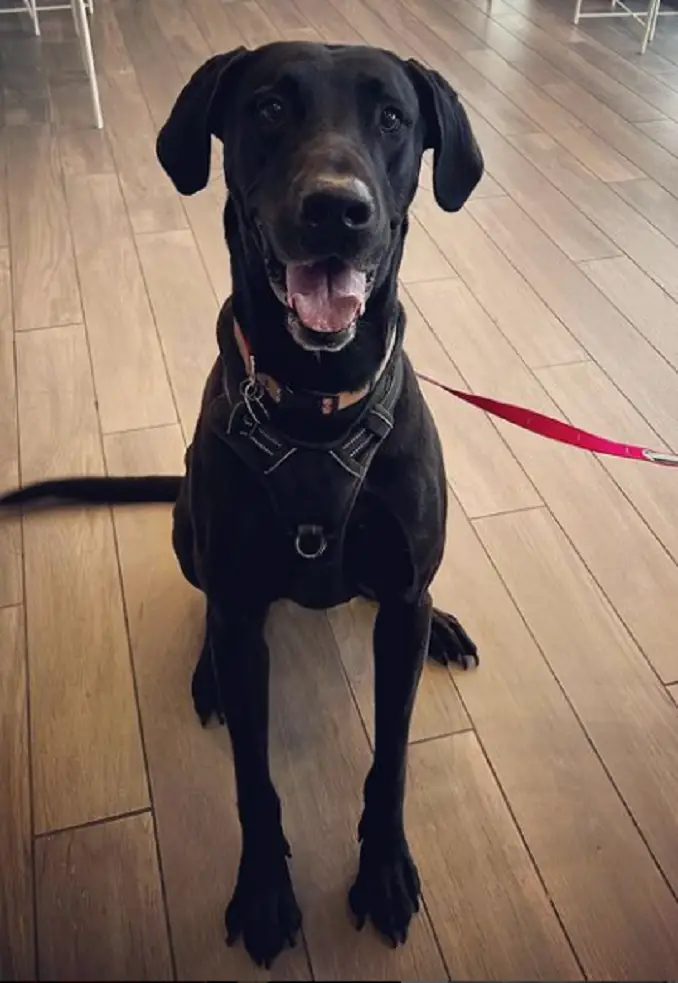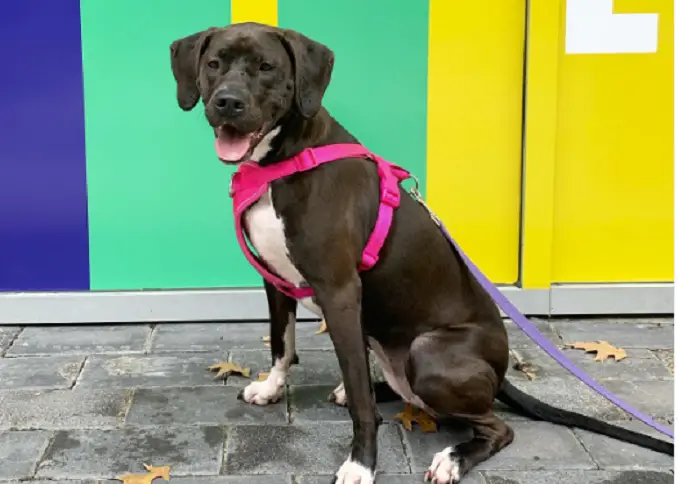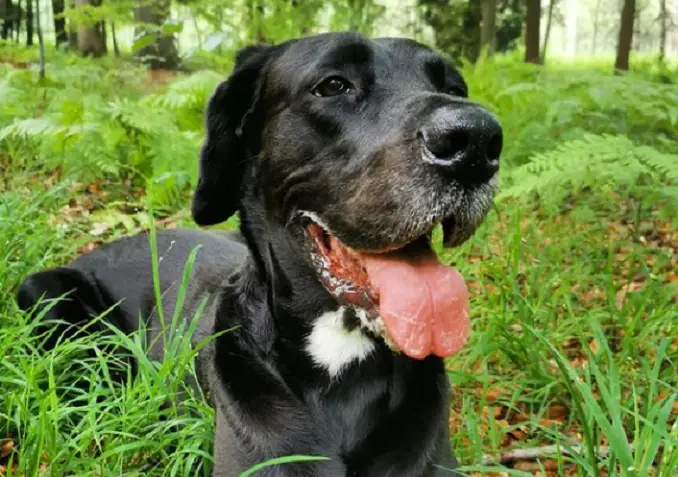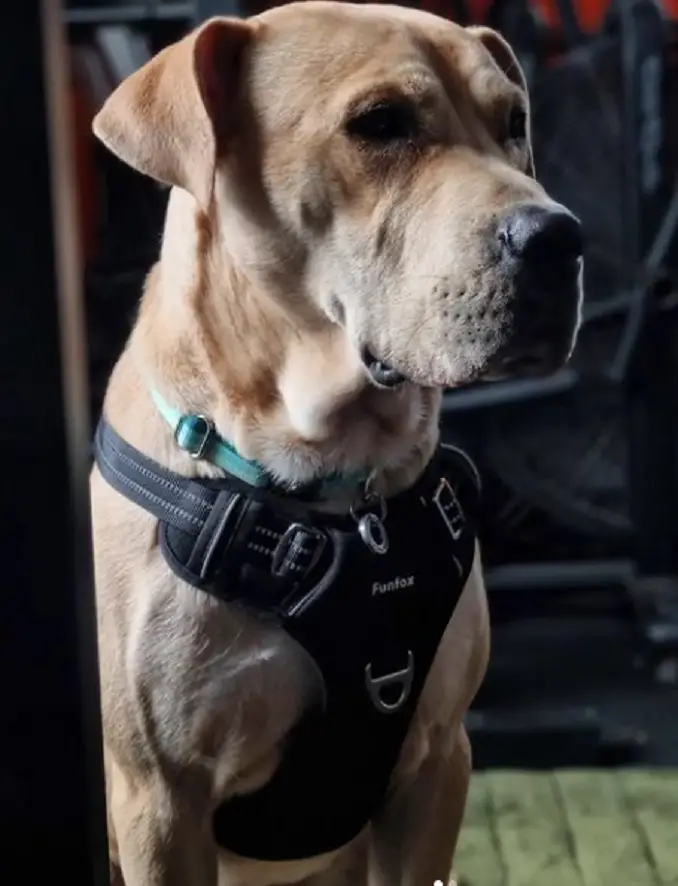Ever since my childhood days with a playful Labrador, I’ve been fascinated by the world of dog breeds, their unique characteristics, and the joy they bring into our lives. This passion led me to the captivating world of mixed breeds, particularly the Great Dane Lab Mix, or as they’re affectionately known, the “Labradane.” This hybrid is a blend of the noble Great Dane and the ever-loyal Labrador Retriever, creating a breed that’s as intriguing as it is loveable.
The Labradane inherits its impressive stature and gentle demeanor from the Great Dane, while the Labrador Retriever contributes its intelligence and affable nature. This mix results in a dog that is both commanding in presence and sweet in temperament, suitable for families and individuals alike. They are known for their loyalty, adaptability, and the ability to form strong bonds with their owners, making them not just pets, but cherished members of the family.
Curious about the Great Dane Lab Mix? Keep on reading and let me share what I know about this breed, including its history, personality, care requirements, and more.
TABLE OF CONTENTS
- Great Dane Lab Mix Quick Breed Summary
- The Origins of the Great Dane Labrador
- Great Dane Lab Mix Appearance
- Great Dane Lab Mix Personality and Temperament
- Great Dane Lab Mix Care
- How to Train a Great Dane Lab Mix
- Common Health Concerns in Great Dane Labs
- The Cost of Owning a Great Dane Lab Mix
- FAQs About Great Dane Lab Mixes
- Is a Great Dane Lab Mix Right for You?
Great Dane Lab Mix Quick Breed Summary
| Common names | Great Dane Lab Mix, Labradane |
| Parent Breeds | Labrador Retriever and Great Dane |
| Breed Group | Hybrid |
| Size | Large |
| Height | 24 to 30 inches |
| Weight | 100 to 180 pounds |
| Colors | Black, chocolate, fawn, merle, yellow |
| Coat | Short to medium length, smooth and dense |
| Life expectancy | 8 to 12 years |
| Temperament | Affectionate, loyal, intelligent, friendly, calm, adaptable |
| Shedding | Moderate to heavy |
| Barking tendency | Minimal |
| Cost | $300 to $800 |
The Origins of the Great Dane Labrador

Delving into the roots of the Great Dane and the Labrador Retriever is like opening a fascinating chapter in the tapestry of canine history. Each breed brings a rich, distinct past, shaping not only their physical attributes and temperament but also their place in human society. These histories lay the foundation for understanding the unique blend that is the Labradane.
Origins of the Great Dane
The Great Dane, often referred to as the “Apollo of Dogs,” boasts a history that is as grand as its stature. Originating in Germany, these dogs were not always the gentle giants we know today.
Initially bred for hunting wild boar, the Great Dane’s ancestors were prized for their courage, strength, and ferocity. However, as hunting needs changed, so did the breed. By the 16th century, Great Danes had transitioned from fierce hunters to noble estate guardians and companions of the European elite.
This transformation marked the beginning of the Great Dane as we recognize it now – a breed known more for its size, elegance, and gentle temperament than its hunting prowess. Over the years, selective breeding accentuated these traits, leading to the affectionate and placid dogs that have captured the hearts of dog lovers worldwide.
Origins of the Labrador Retriever
The Labrador Retriever’s story begins in the early 19th century, far from the manors of Europe, on the island of Newfoundland. Here, they were not initially known as Labradors but as St. John’s dogs, named after the capital city of Newfoundland.
These dogs were bred by local fishermen to help retrieve fishing nets and catch fish that escaped from the lines, showcasing their superb swimming abilities and willingness to work in harsh conditions.
It was the breed’s introduction to Britain in the 19th century that marked a turning point. English nobles took a keen interest in these skilled retrievers, and through selective breeding, they refined the breed into the Labrador Retriever we know today. Famous for their intelligence, good temperament, and versatility, Labradors quickly rose in popularity, not just as working dogs but as beloved family pets.
Great Dane Lab Mix Appearance

The Labradane stands as a testament to the beauty and diversity of mixed-breed dogs. This hybrid captures the imagination not just with its size and stature, but also through its unique combination of physical traits inherited from its parent breeds.
Height and Weight
The Labradane’s size is one of its most notable features, often inheriting the Great Dane’s impressive height. Typically, these dogs can stand anywhere from 24 to 30 inches at the shoulder. However, their weight can vary more significantly, ranging from 100 to 180 pounds, depending on the dominant genes and gender. This considerable size range reflects the influence of both the muscular, large-boned Great Dane and the more moderately sized Labrador Retriever.
Coat
When it comes to their coat, Labradanes often have short to medium-length fur that is relatively easy to care for. The texture of their coat is typically smooth and dense, providing a good balance between the sleek coat of the Labrador and the slightly thicker fur of the Great Dane. This quality makes the Labradane an adaptable companion, capable of handling various climates while maintaining a manageable grooming routine.
Colors
The color palette of the Labradane’s coat is diverse, drawing from the wide range of hues seen in both Great Danes and Labradors. Common colors include black, chocolate, fawn, merle, and even the iconic yellow of the Labrador. Some Labradanes may also exhibit a mix of colors or unique markings, reflecting the genetic variety inherent in mixed breeds. This multitude of possible colors adds to the individuality of each Labradane, making every dog distinct in their appearance.
Great Dane Lab Mix Personality and Temperament
The Great Dane Lab Mix, or Labradane, is a unique combination of the temperamental traits of its parent breeds – the gentle giant Great Dane and the friendly, outgoing Labrador Retriever. This mix results in a personality that is both endearing and complex, suitable for a variety of family environments.
Affectionate and Loyal
Labradanes are known for their deep affection and loyalty toward their owners. This trait is a direct inheritance from both parent breeds, renowned for their devotion to their human families. They tend to form strong bonds with their owners and can be quite protective. This mix of breeds often results in a dog that is loving and gentle with family members, including children, making them excellent family pets.
Intelligent and Trainable
Inheriting the Labrador’s intelligence and the Great Dane’s eagerness to please, Labradanes are generally easy to train and quick to learn. They respond well to positive reinforcement techniques and are known for their ability to pick up on commands and behaviors quickly. This trainability makes them suitable for a range of activities, from basic obedience to more advanced training for specific tasks.
Social and Friendly
Labradanes typically exhibit a friendly and social demeanor, a trait they share with the Labrador Retriever. They enjoy the company of people and other dogs, making them great companions for social activities and family gatherings. However, due to their size, it’s important to socialize them from a young age to ensure they are well-behaved and comfortable in various settings.
Calm and Composed
One of the most cherished traits of the Great Dane is its calm and composed nature, which often translates well into the Labradane. Despite their large size, they are typically gentle and can be quite laid-back, especially as they grow older. This calmness makes them suitable for both active and more relaxed households.
Adaptable
The Labradane’s mixed heritage gives them a degree of adaptability that makes them suitable for various living conditions. They can thrive in both rural and urban settings, provided they have enough space to move around and regular exercise. Their adaptable nature, combined with their friendly temperament, makes them versatile companions for different lifestyles.
Great Dane Lab Mix Care

Raising a Great Dane Lab Mix is both a joy and a responsibility. This unique breed has specific needs in terms of feeding, grooming, exercise, and mental stimulation.
Food Needs
A Labradane’s food requirement ranges from 4 to 10 cups daily, split between two meals. The exact amount varies based on their metabolism, age, activity level, and size. It’s advisable to consult with a veterinarian to determine the ideal calorie intake for your specific dog, especially considering the dietary needs of pregnant dogs.
These dogs have a strong appetite and will often eat whatever they can find. To prevent overfeeding, keep food and trash cans out of their reach. Treats should not exceed 10% of their daily calorie allowance. Labradane puppies, with their rapid growth, require specially formulated kibble to support healthy bone development.
Grooming Needs
Despite their short coats, Labradanes shed quite a bit. Weekly grooming, or daily during shedding seasons, is necessary to remove trapped hair and distribute natural oils. During grooming sessions, it’s also important to check their ears and skin for signs of infections or parasites.
These dogs don’t need frequent baths – once every few months or when they get dirty is sufficient. Regular dental care, including brushing their teeth two to three times a week, is essential for maintaining oral health. Nail trimming is also crucial, especially if they don’t naturally wear down their nails.
Exercise Needs
Labradanes require 1-2 hours of exercise each day. Suitable activities include running, walking, swimming, agility, and games like fetch. However, be cautious with Labradane puppies; their exercise should be gentler and proportionate to their age – about five minutes for each month of age, focusing on flat, easy walks to protect their developing bones.
Due to their large size and energetic nature, Labradanes are not well-suited for small, cramped living spaces. They thrive in environments where they have ample space to move and play.
Mental Needs
Besides physical exercise, the Labrador Great Dane Mix needs about an hour of mental stimulation daily. This can include learning new tricks, playing with puzzle toys, engaging in water play, scent work, and interactive games. Keeping their minds active is as important as keeping their bodies fit, preventing boredom and promoting overall well-being.
How to Train a Great Dane Lab Mix

Training a Great Dane Lab Mix requires attention the the intelligence and eagerness of both the Great Dane and Labrador Retriever. Their training needs a specialized approach due to their unique personality and size.
Establishing Leadership
- Consistency is Key: Set clear and consistent rules to establish yourself as the leader. Consistency helps your Labradane understand expectations and boundaries.
- Positive Reinforcement Techniques: Use treats, praise, and affection to reinforce good behavior. This approach is more effective and builds a stronger bond.
- Early Socialization: Expose them to different environments, people, and animals early to ensure they are well-adjusted and sociable.
Obedience Training
- Basic Commands First: Start with essential commands like ‘sit,’ ‘stay,’ ‘come,’ and ‘heel.’ These are crucial for safety and daily interaction.
- Engaging Training Sessions: Keep training sessions short and interesting to hold their attention. Incorporate games and rewards to make learning enjoyable.
- Repetition and Patience: Repeat commands and be patient. Consistent repetition ensures that they understand and remember the training.
Addressing Size and Strength
- Leash Training: Due to their size, teaching them to walk calmly on a leash is essential. Start leash training early to prevent pulling.
- Gentle Play: Teach them to be gentle, especially around children and smaller animals, considering their size and strength.
- No Jumping: Train them not to jump on people or furniture. Redirect this behavior with commands and reinforce it with rewards.
Advanced Training and Activities
- Agility Training: Engage them in agility training or other dog sports for physical and mental stimulation.
- Continuous Learning: Keep challenging them with new commands and tricks to keep their minds active.
- Mental Stimulation Toys: Use puzzle toys and scent games to provide mental enrichment and prevent boredom.
Behavioral Management
- Manage Exuberance: Address over-excitement and jumping with firm, calm commands. Redirect their energy into positive outlets like play or training.
- Chewing Prevention: Provide appropriate chew toys and engage in regular exercise to curb destructive chewing habits.
- Anxiety Reduction: If they show signs of separation anxiety, use crate training and leave them with engaging toys when alone.
Common Health Concerns in Great Dane Labs
Great Dane Lab mixes are generally robust dogs. However, their large size and genetic background can predispose them to certain health conditions. Being aware of these common concerns and understanding how to manage them is essential for the well-being of your Labradane.
Dilated Cardiomyopathy
This heart disease involves an abnormally large and poorly functioning heart. Symptoms of Dilated Cardiomyopathy include lethargy, labored breathing, coughing, and excessive panting. It’s a serious condition that affects the dog’s overall health and stamina.
- Medication and Diuretics: Treatment usually involves medication to improve heart function and diuretics to reduce fluid buildup.
- Regular Vet Check-ups: Early detection through regular heart screenings is vital.
- Monitoring for Symptoms: Keeping an eye on any signs of heart distress is crucial for timely intervention.
Bloat
Bloat is a critical condition where the stomach distends and twists, leading to life-threatening complications. Symptoms include a swollen belly, lethargy, retching, and excessive drooling.
- Immediate Veterinary Care: Bloat requires urgent veterinary attention as it is a medical emergency.
- Preventative Measures: Feeding smaller, more frequent meals and avoiding vigorous exercise right after eating can help prevent bloat.
Hip Dysplasia
Hip dysplasia occurs when the hip joint is malformed, causing pain and lameness. It’s particularly concerning due to Labradane’s rapid growth and large size.
- Weight Management: Keeping your dog at a healthy weight to minimize joint stress.
- Physiotherapy and Surgery: Depending on severity, treatments can include physiotherapy, lifestyle changes, dietary adjustments, and possibly surgery.
- Regular Exercise: Engaging in low-impact exercises to strengthen the muscles around the joint.
Progressive Retinal Atrophy (PRA)
PRA is an inherited eye disease leading to retinal deterioration and eventual blindness. There’s no cure, making it a significant concern for aging Labradanes.
- Environmental Adjustments: Adapting your home environment to accommodate a visually impaired dog.
- Regular Eye Examinations: Monitoring eye health through regular veterinary check-ups.
Hypothyroidism
Hypothyroidism involves insufficient thyroid hormone production, leading to symptoms like lethargy, obesity, cold sensitivity, and hair loss or thinning.
- Long-term Medication: Treatment usually involves daily medication to supplement thyroid hormone levels.
- Diet and Exercise: Managing diet and exercise to help control symptoms like obesity.
- Regular Blood Tests: Monitoring thyroid levels through regular blood tests to adjust medication as needed.
Wobbler Syndrome
Wobbler Syndrome affects the cervical spine, leading to symptoms like a wobbly gait, neck pain, stiffness, paralysis, and lameness. This neurological condition occurs due to compression of the spinal cord and nerve roots in the neck region, which can significantly affect the dog’s mobility and quality of life.
- Surgery and Medications: Treatment may involve surgery and anti-inflammatory medications.
- Activity Restriction: Limiting physical activity to reduce stress on the spine.
- Supportive Care: Providing a comfortable living environment to ease symptoms.
The Cost of Owning a Great Dane Lab Mix
Owning a Lab Great Dane Mix, or Labradane, can be a fulfilling experience, but it’s important to understand the financial commitment involved. From initial costs to ongoing expenses, here’s a breakdown to help potential owners prepare for the financial aspect of caring for a Labradane.
Initial Costs
- Purchase Price: The cost to purchase a Labradane puppy can vary widely depending on the breeder, location, and lineage. Prices typically range from $300 to $800.
- Initial Veterinary Care: Initial vaccinations, microchipping, and spaying or neutering are essential. This can cost anywhere from $100 to $300.
- Supplies: Basic supplies include a bed, collar, leash, food and water bowls, and toys. Expect to spend around $100 to $200 initially.
Ongoing Costs
- Food Expenses: Labradanes are large dogs with considerable appetites. High-quality dog food tailored for large breeds can cost around $60 to $100 per month.
- Veterinary Care: Regular check-ups, vaccinations, and preventive medications for fleas, ticks, and heartworms can add up to $500 to $700 annually.
- Grooming: While grooming needs are moderate, professional grooming sessions, if opted for, can cost around $30 to $70 per visit.
Potential Health Care Costs
- Emergency Care: It’s important to set aside funds or consider pet insurance for unexpected health issues. Emergency care costs can range significantly.
- Chronic Health Condition Management: Managing conditions like hip dysplasia or heart issues can involve ongoing medication or treatment, potentially adding hundreds to thousands of dollars to annual expenses.
Additional Costs
- Training: Professional training classes or resources can be beneficial, especially for first-time owners of large breeds. This can cost $50 to $200 for basic training sessions.
- Pet Insurance: To offset potential medical costs, pet insurance can be a wise investment, typically ranging from $30 to $70 per month.
- Miscellaneous: Other costs can include dog walking services, boarding fees for vacations, and replacement of toys and supplies.
FAQs About Great Dane Lab Mixes
How long does a Great Dane Lab mix live?
Great Dane Lab mixes typically have a lifespan of about 8 to 12 years. Proper care, a healthy diet, and regular veterinary check-ups can contribute to a longer, healthier life.
Can the Great Dane Lab mix live with other pets?
Yes, Great Dane Lab mixes usually get along well with other pets. Early socialization and proper introduction are key to fostering harmonious relationships with other animals in the household.
Are Great Dane Lab mixes good family dogs?
Absolutely, Great Dane Lab mixes are known for being affectionate and loyal, making them excellent family dogs. Their friendly and gentle nature suits households with children.
Do Great Lab mixes bark a lot?
Great Dane Lab mixes do not typically bark excessively. They may bark to alert their owners or express excitement, but they are generally not known as frequent barkers.
Is a Great Dane Lab mix easy to train?
Yes, Great Dane Lab mixes are relatively easy to train. They inherit intelligence and eagerness to please from both parent breeds, making them responsive to training.
Do Great Dane Labs shed a lot?
They shed moderately. Regular brushing, especially during shedding seasons, can help manage their short, dense coat and keep shedding under control.
Is a Great Dane Lab Mix Right for You?
After exploring the unique characteristics, care requirements, and personality traits of the Great Dane Lab Mix, or Labradane, it’s clear that they are a remarkable breed. However, determining if a Labradane is the right fit for you depends on various factors including your lifestyle, living space, and experience with dogs.
Labradanes Are Suitable For
- Active Individuals and Families: Labradanes thrive in active households that can provide them with regular exercise and engagement.
- Owners with Ample Space: Due to their size, they are better suited for homes with spacious indoor living areas and secure outdoor spaces.
- Experienced Dog Owners: Those familiar with large breeds will understand their physical and training needs, ensuring a happy, well-adjusted dog.
Labradanes Are NOT Suitable For
- Apartment Living: Their size and energy levels make them less suitable for small apartments or homes without yards.
- First-Time Dog Owners: Without experience in handling and training large breeds, new dog owners might find Labradanes challenging.
- Busy Schedules: Owners who cannot dedicate time to regular exercise, training, and companionship may struggle to meet the needs of a Labradane.


Be the first to comment